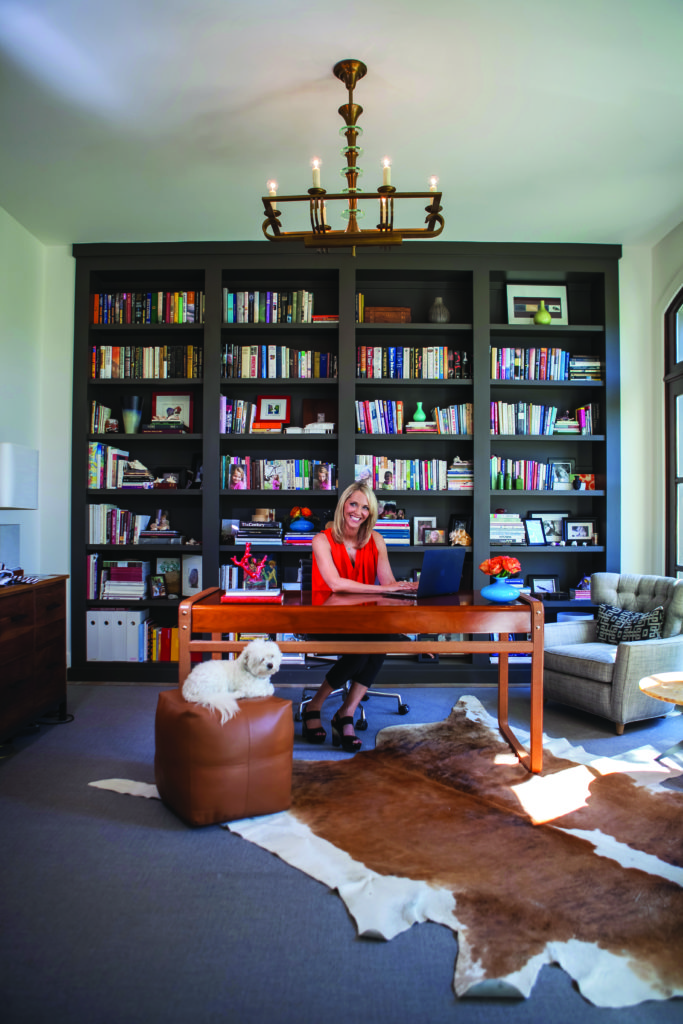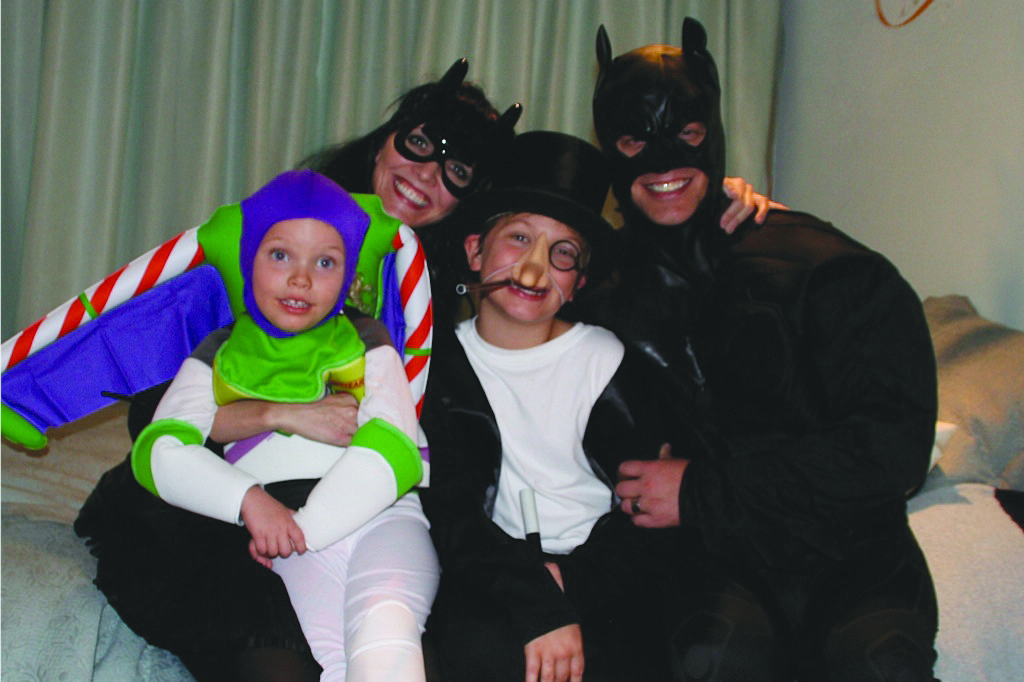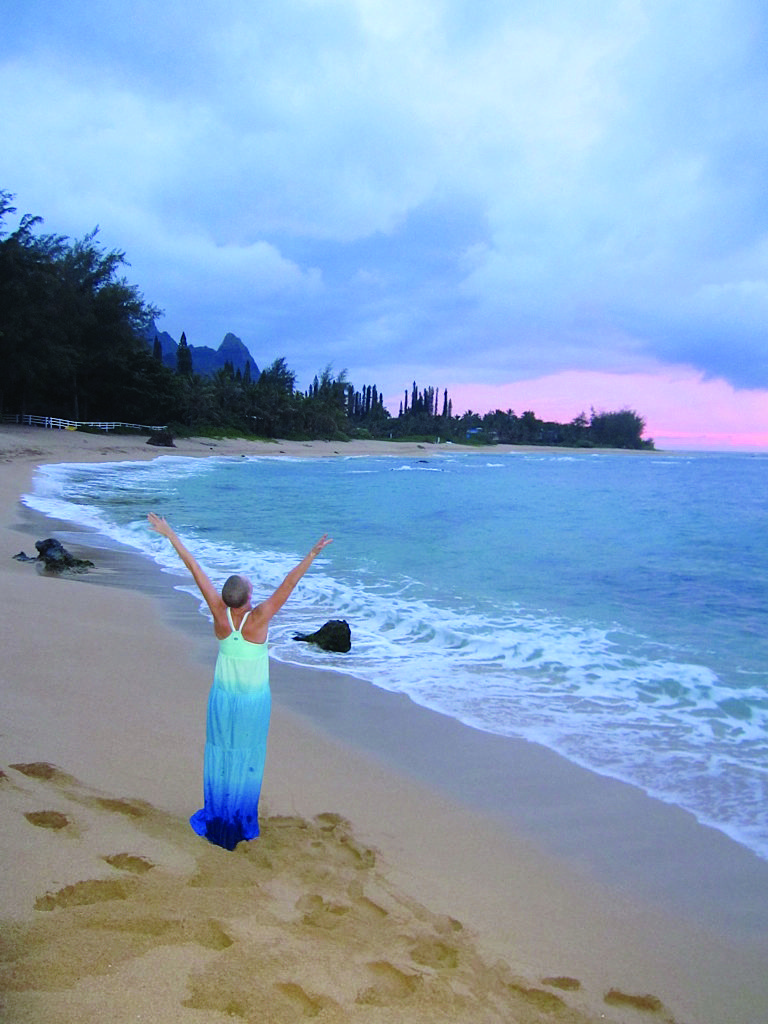Patti Rogers’ unique online community site, Rallyhood, was born out of personal necessity—to pull people together with a passion and a purpose.
By Jennifer Hill Robenalt, Photos By Annie Ray

Every superhero has an origin story. On October 31, 2008, Patti Rogers was Batgirl, the powerfully autonomous defender of justice known as one of the most brilliant heroes of the DC Comics pantheon of characters. Fearless and known for her particularly stellar computer skills, Batgirl seemed an obvious choice for Rogers. Her husband Michael, a tech entrepreneur in the software space, was going to be Batman. And as Austin’s unofficial mascots and protectors, bat culture would be well-represented by the power couple known to have contributed handily to Austin’s burgeoning entrepreneurial landscape.
But as Rogers took an exit off Mopac to pick up her kids, Ethan and Zoe, for the massive Halloween party at their home that night, she couldn’t have imagined that her own origin story would change forever. Before arriving at the school, Rogers got a phone call from her doctor. It was cancer. They would need to do a battery of tests and create a treatment plan. Immediately.
“I was actually sure they had the wrong person and spelled my name to be sure they had the right name. I just kept the information in a pocket. I didn’t tell my husband until I kicked the last neighbor out of the house and unplugged the margarita machine. He was, by that time, sleeping on the couch and I woke him up and said to him ‘I have something to tell you.’ I will never forget how he met me in this place of positivity and faith and he just looked me dead in the eyes and said, ‘We got this.’”
THE GATHERING

On her 46th birthday, in her modern, elegant and well-appointed house in an established gated community in Barton Creek, Rogers described the evolution of a life derailed and rerouted. Her home was calm and filled with light pouring over ethereal and naturalistic abstracts against clean lines of furniture. Bright and fit with sunny blonde hair, Rogers has created an oasis which relays a design-forward aesthetic of someone who deeply enjoys simplicity, nature, wide-open spaces and experiences above affectation.
Patti Rogers was born in Chicago but moved to Texas when she was 4 years old. Her mother and father, both successful entrepreneurs, instilled a powerful work ethic into each of their four daughters. By example, Rogers learned that conceiving, planning and executing an idea was not only possible but also a birthright. Goals could be made and met, and futures could be envisioned and achieved. But for Rogers, the cancer diagnosis suddenly presented a dark unknown that would not only challenge her physically, but present a deeper set of questions about life, love, community and purpose.
In college, Rogers earned a swimming scholarship to the University of Hawaii. She later finished her English degree at the University of Texas at Austin. After graduation, she headed to parts unknown—two years in Washington, D.C., and another two in Los Angeles—where she honed her marketing, branding and design skills. But reconnecting with her Anderson High school sweetheart brought her back to Austin, and here she stayed. In 1992, she started her first business.
“I had a company called the Olsen group—a marketing and advertising company,” she tells me. “We focused on doing print and corporate branding collateral for mostly high-tech companies during that time. And then we moved into interactive. I sold that business in 2002 and really took the opportunity to dive into the world of volunteering and helping my kids’ school.”
And, like many mothers who transition back home after working long hours, the monumental task of organizing a household, a family, personal goals and community commitments proved to be just as demanding on her time and energy, if not more.
“That was really an eye-opening time for me because I realized for the first time that volunteers actually make the world go round. There is so much work outside of ‘work’ that happens. I could see really clearly…this absence of tools to organize activities within non-enterprise projects. And every busy parent knows what I’m talking about. The 37 emails surround the Valentine’s Day party. The inefficiency of communicating dates for a committee or a board. There was a lack of tools.”
Rogers was inspired by people within her community at her children’s school, St. Gabriel’s Catholic school, including Dr. Judith Knotts and Jeff Serra. There were also Tessa Lewis, Aileenavilles, Lynn Sargent and Lynn Meredith, among many others.
“They were real leaders and selfless givers in that community,” Rogers says. “I’ve been so inspired by that and taking that forward in my heart. I witnessed how hard these people work. They weren’t doing it for a name on the wall or to get credit. They were doing it because they believed in the impact that their work would have on a small community and then ultimately a broader community. I just observed that hard, hard work and selfless giving of their professional skills.”

After the cancer diagnosis, Rogers’s view of the power of community deepened. A conversation with her sister made it clear that now was the time to ask for help. And it wasn’t easy.
“While cancer is all the things that it is—it’s inconvenient, and it’s scary and it’s totally un- glamorous—it really truly was such a blessing in the deepest sense of the word in my life for so many reasons,” Rogers recalls. “It wasn’t cancer that changed my life; it was kindness. And it was community that changed my life. No matter who you are—how brilliant, strong or successful— real-life community connections matter. We all need help, and asking for it is difficult. But the gift of letting love in is one of the most profound gifts you can ever give to yourself and the people around you.”
When Rogers was sick, her community brought the love. Neighbors, friends, church members and even people she barely knew came forward to help make things a little easier for her and her family.

“You want to conserve your energy for getting well,” Rogers explains. “The last thing you want to do is make something or wash something, or even just having to think about going to the grocery store was sort of a daunting task because you just don’t feel good. I had some friends who went to mass every Friday and said the rosary for me. I have other friends who missed vacations and workouts. That changes you because you feel
forever blessed by that kindness. And I truly feel it is my honor to take that kindness forward and spread it all around. And it is at the heart of the inspiration for Rallyhood.”
During her treatment, Rogers made the decision to clear the clutter and focus on the present. No more galas. No more committees. No more obligatory dinners. The cancer, it seemed, forced a tide change in how she viewed the world and what to do with the life she had. Rallyhood was taking root, and now she had the time to consider its full potential.
“Because of the white space in my life, because I had cleared my life, I had the benefit of being able to hear the inspiration, and I know that’s a gift too,” Rogers says. “I know that if i had been obligated or overly committed by other activities, I might have just missed the inspiration or thought of all the reasons why not. But instead I could see clearly the vision of building a platform for communities.”
TIME TO RALLY
About two months after Rogers’s last surgery in early 2010, the culmination of her instincts and experiences finally came together. Rogers considered the challenges of running an organized life after the sale of her company. She contemplated the powerful impact of volunteer contributions at her children’s school and in her
professional network. She sat in deep gratitude for the outpouring of love and support that she and her family received during her treatment. The common thread was the limitless need for human beings to connect, organize and help one another. But the challenge was to develop a comprehensive platform to empower people to work more efficiently and easily in order for the human touch to emerge organically.
“I heard clearly the words ‘Rallyhood’—‘rally’ being about pulling people together with purpose, and ‘hood’ being the community piece,” Rogers explains. “We waste so much time when things are disorganized. That time is precious and everyday counts. When things are disorganized it creates stress in our life. It creates unnecessary
chaos in our life. And those two things—chaos and stress—equal disease. If we could help organize group communication inside communities and how we work and play in groups…the trickle down would have a positive impact on life.”
Rogers realized that women, like her, are always seeking resources and tools to help them be better friends, moms, neighbors and community leaders. In doing research, it became clear that silo solutions like Evite, sign up genius and PayPal could only provide pieces to the bigger, more complicated puzzle of helping someone in need, organizing a group or changing the flow of communications and organization in a company or nonprofit. In Rogers’s view, the marketplace desperately needed aggregated tools in one place.
“We don’t live a siloed life,” Rogers explains. “We don’t live a life with our kids’ activities, a life with our nonprofit causes, a life with work, a life with our personal fitness groups. We have one life, and we have one calendar. We need help with that.”
Soon after Rogers conceived the idea of Rallyhood, and with consulting support from her husband, the company announced a $1.3 million round of funding with financing led by Tom Meredith, co-founder and managing partner of Meritage Capital and former SVP and CFO at Dell. The capital was used to get new customers and develop products. she hired a small staff and got to work.
Rogers was determined to solve the problem of having to log in to multiple accounts across many different social tools and networks in order to share information and coordinate efforts in real-world scenarios. She wanted users to be able to share photos, files, event information, make payments and communicate with one another all
around a specific person, cause, event, committee or organization. For individuals, every aspect of life including home, community involvement, personal time and work should be integrated into one application. Users could receive a personalized calendar notice every day filled with reminders, information and opportunities to engage without leaving the application featuring integrated tools such as maps and pay services. She conceived a free site offering a “freemium” model, where users can get an account for free but upgrade to more powerful features within the platform.
Rallyhood is currently the only social app that incorporates all the group communication, coordination and sharing tools in one place. In 2012, Rallyhood’s beta testing generated 7,500 active users across 2,000 Rally- sites. Now officially out of beta, the company’s mission is to gain more users and continue to build relationships with major organizations across the country, while also providing a simple, yet powerful tool for small groups and individuals.
“We’re really excited about a couple of really important partnerships that we have—Livestrong patient support and we have just begun a partnership with Dell Children’s to create patient and family support sites for their community,” Rogers says “
And we have a strong and growing relation- ship with girl scouts around the country, both on the troop level and on the council level.” And for everyday users, Rallyhood can be used for anything involving a variety of people, activities, purchases, events, destinations and goals. It’s popular among soccer teams, triathlete communities and schools. Even friends and families who are looking for ways to help new parents can organize a safe online space for photos, food trees, visits, gifts, email communications and even a blog around the arrival of a baby. It takes rallying to a whole new level.
A NEW BAT SIGNAL
In Native american mythology, bats are powerful and complex creatures. The bat totem can represent an impetus for transformation. And the presence of a bat can signal profound change is afoot. Bats are nocturnal creatures which thrive in communities and awaken in the dark. Some say they are messengers that provide a chance to face one’s darkest fears, and to consider the possibility of a new life—a rebirth. According to lore, bats beg those who come across them not to be afraid, and to face the darkness with a sense of hope, togetherness and opportunity.
Almost five years after that scary Halloween in 2008 as Batgirl, and three years after her final surgery, Rogers has survived cancer. In the process, she found that communities can illuminate the darkness, strengthen communities and create the connections that can transform lives.
“I tell my kids all the time: It’s not about what happens to you. It’s about what you do with it. Choose up or choose down. Which one is it? I was determined that this was not going to bury me. It was going to plant me, and then from here I would grow.”


